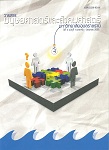พฤติกรรมการเดินทางและทัศนคติของประชาชนต่อศาสนสถาน และแหล่งประวัติศาสตร์ในเขตเทศบาลนครอุบลราชธานี
Main Article Content
บทคัดย่อ
การวิจัยนี้มีวัตถุประสงค์เพื่อศึกษาทัศนคติและความต้องการของประชาชนต่อศาสนสถาน และแหล่งประวัติศาสตร์ เพื่อการท่องเที่ยวในเขตเทศบาลนครอุบลราชธานี โดยใช้การวิจัยแบบสำรวจเพื่อรวบรวมข้อมูลจากกลุ่มตัวอย่างประชากรที่อาศัยอยู่ในจังหวัดอุบลราชธานีจำนวน 600 คน ในช่วงเดือนพฤษภาคม 2549 ผลการศึกษาพบว่า พฤติกรรมการเข้าไปในเขตเมืองเก่าอุบลราชธานีนั้นเป็นไปเพื่อซื้อของ ทำงาน ติดต่อธุรกิจ พักผ่อนหย่อนใจ และไหว้พระ โดยเข้ามาประมาณ 1 ครั้งต่อสัปดาห์และเดินทางโดยรถยนต์ส่วนบุคคล หรือรถจักรยานยนต์ สำหรับทัศนคติเกี่ยวกับเขตเมืองเก่า นั้น กลุ่มตัวอย่างรู้จักศาสนสถาน และแหล่งประวัติศาสตร์ต่าง ๆ ในเขตเมืองเก่า แต่สถานที่ที่รูจั้ก เคยไปและพึงพอใจมากที่สุดได้แก่ทุ่งศรีเมือง โดยไปประมาณ 1-2 ครั้งตอ่ สัปดาห์ ส่วนเหตุผลที่ไม่อยากเข้ามาในเขตเมืองเก่า เพราะปัญหาเรื่องการจราจรติดขัด มลพิษทางอากาศและเสียง การขาดที่จอดรถ และการขาดเส้นทางสำหรับจักรยาน ส่วนภาพลักษณ์ของเขตเมืองเก่าในปัจจุบันและอนาคตนั้น กลุ่มตัวอย่างเห็นด้วยมากหรือมากที่สุดในเรื่องการเป็นแหล่งประวัติศาสตร์ โบราณคดีและศาสนสถาน และต้องการให้พัฒนาพื้นที่ด้านกายภาพและภูมิทัศน์ทั้งในเขตศาสนสถานและเขตเมืองเก่า ให้เป็นที่สำหรับการพักผ่อนหย่อนใจ โดยในเขตศาสนสถานนั้นต้องการให้มีความร่มรื่นและมีสิ่งอำนวยความสะดวกภายในวัดและป้ายข้อมูลประชาสัมพันธ์เพื่อการเรียนรู้ สำหรับผู้มาเยี่ยมชม ส่วนในเขตเมืองเก่านั้นต้องการให้ปรับปรุงสภาพริมแม่น้ำมูล เพิ่มพื้นที่สวนสาธารณะและมีสิ่งอำนวยความสะดวก เช่น สุขา ถังขยะ เก้าอี้นั่ง เป็นต้น
Travel Behavior and Attitudes of Local Population regarding Religious and Historical Places in the Ubon Ratchathani Municipal Area
The purpose of this research was to study the attitudes of residents toward guidelines on the conservation of religious and historical places for tourism in the Ubon Ratchathani municipal area. Data were collected by surveys from 600 Ubon Ratchathani residents in May 2006. Results showed that the residents went to the city area once a week by personal cars or motorbikes for purchasing goods/services, work, business, leisure, and worship. The religious and historical places were recognized but Thung Sri Muang was the place residents knew, used, were most satisfied with, and went to about 1-2 times a week. However, residents did not want to go to the city because of traffic congestion, air and noise pollution, and the scarcity of parking areas and bike lanes. Regarding the present and future images of the city, residents agreed with the city’s image as a historical, archaeological, and religious place. Also, the physical and landscape development of the town needed to have leisure and relaxation areas. This was particularly the case at the temples, where the grounds, facilities, and information for visitors should be developed, and the public areas along the Mun River, where an increasing number of facilities, such as toilets, garbage bins, and seating were required.
Article Details
บทความที่ได้รับการตีพิมพ์เป็นลิขสิทธิ์ของวารสารมนุษยศาสตร์และสังคมศาสตร์ มหาวิทยาลัยอุบลราชธานี
ข้อความที่ปรากฏในบทความแต่ละเรื่องในวารสารวิชาการเล่มนี้เป็นความคิดเห็นส่วนตัวของผู้เขียนแต่ละท่านไม่เกี่ยวข้องกับมหาวิทยาลัยอุบลราชธานี และคณาจารย์ท่านอื่นๆในมหาวิทยาลัยฯ แต่อย่างใด ความรับผิดชอบองค์ประกอบทั้งหมดของบทความแต่ละเรื่องเป็นของผู้เขียนแต่ละท่าน หากมีความผิดพลาดใดๆ ผู้เขียนแต่ละท่านจะรับผิดชอบบทความของตนเองแต่ผู้เดียว


